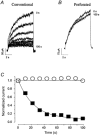Functional consequences of the arrhythmogenic G306R KvLQT1 K+ channel mutant probed by viral gene transfer in cardiomyocytes
- PMID: 11351021
- PMCID: PMC2278611
- DOI: 10.1111/j.1469-7793.2001.0127b.x
Functional consequences of the arrhythmogenic G306R KvLQT1 K+ channel mutant probed by viral gene transfer in cardiomyocytes
Abstract
IKs, the slow component of the delayed rectifier potassium current, figures prominently in the repolarization of heart cells. The K+ channel gene KvLQT1 is mutated in the heritable long QT (LQT) syndrome. Heterologous coexpression of KvLQT1 and the accessory protein minK yields an IKs-like current. Nevertheless, the links between KvLQT1 and cardiac IKs are largely inferential. Since the LQT syndrome mutant KvLQT1-G306R suppresses channel activity when coexpressed with wild-type KvLQT1 in a heterologous system, overexpression of this mutant in cardiomyocytes should reduce or eliminate native IKs if KvLQT1 is indeed the major molecular component of this current. To test this idea, we created the adenovirus AdRMGI-KvLQT1-G306R, which overexpresses KvLQT1-G306R channels. In > 60 % of neonatal mouse myocytes, a sizable IKs could be measured using perforated-patch recordings (8.0 +/- 1.6 pA pF-1, n = 13). IKs was increased by forskolin and blocked by clofilium or indapamide but not by E-4031. While cells infected with a reporter virus expressing only green fluorescent protein (GFP) displayed IKs similar to that in uninfected cells, AdRMGI-KvLQT1-G306R-infected cells showed a significantly reduced IKs (2.4 +/- 1.1 pA pF-1, n = 10, P < 0.01) when measured 60-72 h after infection. Similar results were observed in adult guinea-pig myocytes (5.9 +/- 1.2 pA pF-1, n = 9, for control vs. 0.1 +/- 0.1 pA pF-1, n = 5, for AdRMGI-KvLQT1-G306R-infected cells). We conclude that KvLQT1 is the major molecular component of IKs. Our results further establish a dominant-negative mechanism for the G306R LQT syndrome mutation.
Figures




References
-
- Arena JP, Kass RS. Block of heart potassium channels by clofilium and its tertiary analogs: relationship between drug structure and type of channel blocked. Molecular Pharmacology. 1988;34:60–66. - PubMed
-
- Barhanin J, Lesage F, Guillemare E, Fink M, Lazdunski M, Romey G. KvLQT1 and lsK (minK) proteins associate to form the IKs cardiac potassium current. Nature. 1996;384:78–80. - PubMed
-
- Barry DM, Xu H, Schuessler RB, Nerbonne JM. Functional knockout of the transient outward current, long-QT syndrome, and cardiac remodeling in mice expressing a dominant-negative Kv4 alpha subunit. Circulation Research. 1998;83:560–567. - PubMed
-
- Colatsky TJ, Follmer CH, Starmer CF. Channel specificity in antiarrhythmic drug action. Mechanism of potassium channel block and its role in suppressing and aggravating cardiac arrhythmias. Circulation. 1990;82:2235–2242. - PubMed
-
- Hamill OP, Marty A, Neher E, Sakmann B, Sigworth FJ. Improved patch-clamp techniques for high-resolution current recording from cells and cell-free membrane patches. Pflügers Archiv. 1981;391:85–100. - PubMed
Publication types
MeSH terms
Substances
Grants and funding
LinkOut - more resources
Full Text Sources
Other Literature Sources

